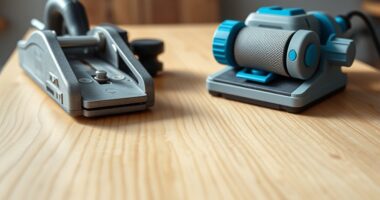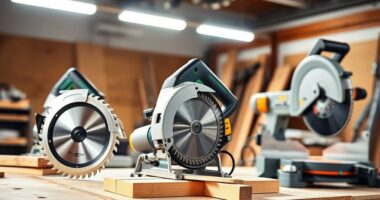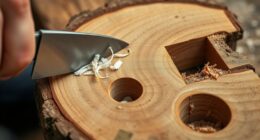Understanding SCFM (standard cubic feet per minute) tells you how much air your compressor can deliver, which is essential for running tools efficiently. The duty cycle indicates how long the compressor can operate before needing a rest to prevent overheating. Selecting the right compressor means balancing these factors based on your woodshop’s workload. If you want to guarantee smooth operation and avoid surprises, keeping these details in mind will help you make an informed choice. More tips await as you explore further.
Key Takeaways
- SCFM measures the compressor’s airflow capacity at standard conditions, indicating suitable power for woodworking tools.
- Duty cycle reflects how long a compressor can operate continuously without overheating, affecting work session duration.
- Select an compressor with appropriate SCFM ratings to match the airflow demands of your woodshop tools.
- A higher duty cycle (often 50% or more) allows longer operation, essential for continuous woodworking tasks.
- Proper maintenance reduces noise and ensures the compressor runs efficiently within its SCFM and duty cycle specifications.

Air compressors are essential tools in any woodshop, providing a reliable power source for a variety of tasks. Whether you’re powering nail guns, spray guns, or other pneumatic tools, understanding how to keep your compressor in top shape is key. Proper compressor maintenance not only extends the lifespan of your equipment but also ensures it operates efficiently and safely. Regularly checking and replacing air filters, draining moisture from the tank, and inspecting hoses for leaks are simple steps that can prevent costly breakdowns. Maintenance also involves lubricating moving parts when needed and keeping the compressor clean to avoid dust buildup, which can impair performance. Staying on top of these tasks helps you avoid unexpected downtime and keeps your workspace safe.
When it comes to noise reduction, it’s a common concern in a busy woodshop. Compressors can be loud, which may disturb your workflow or bother nearby areas. To address this, consider investing in models with noise-reducing features or adding soundproof enclosures around the compressor. Installing rubber pads or mats underneath the unit can also absorb vibrations and dampen sound. Proper placement of the compressor—away from work stations and in a well-ventilated area—can substantially reduce noise impact. Regular compressor maintenance plays a role here as well; a well-maintained compressor runs more smoothly and quietly. For example, a dirty or worn-out piston or air filter can cause the unit to work harder and produce more noise. Keeping these components clean and in good condition minimizes unnecessary noise and prolongs the compressor’s lifespan.
Understanding the importance of compressor maintenance and noise reduction techniques will help you get the most out of your air compressor. A well-maintained compressor operates more quietly and efficiently, giving you a safer, more comfortable work environment. Additionally, paying attention to noise levels ensures you stay compliant with any local noise regulations, especially in shared workshops or commercial settings. Remember, the key to a long-lasting, quiet compressor is regular upkeep and thoughtful placement. By scheduling routine maintenance and taking steps to reduce noise, you make your woodshop safer, more productive, and more enjoyable to work in. Ultimately, investing in these practices not only improves your equipment’s performance but also enhances your overall workflow.
Frequently Asked Questions
How Does Ambient Temperature Affect Compressor Performance?
Ambient temperature directly impacts your compressor efficiency. When it’s hot outside, the compressor works harder to cool the air and prevent overheating, which can reduce performance and lifespan. Conversely, colder temperatures help the compressor run more efficiently since it doesn’t need to dissipate as much heat. To maintain peak performance, make sure your compressor is suited for your ambient conditions and consider additional cooling if temperatures get too high.
What Maintenance Is Needed for Long-Term Compressor Reliability?
Did you know that neglecting maintenance can cut your compressor’s lifespan by up to 50%? To keep it reliable, stick to regular lubrication schedules to prevent engine wear. Also, don’t forget filter maintenance—clean or replace filters often to guarantee ideal airflow and prevent overheating. These small steps protect your investment, reduce downtime, and keep your workshop running smoothly for years to come.
Can Portable Compressors Handle Continuous Woodworking Tasks?
Portable compressors generally can’t handle continuous woodworking tasks because they lack the portable power and high SCFM output needed for sustained use. They tend to overheat and shut down if pushed too hard, and their compressor noise can become a distraction. If your projects demand constant airflow, investing in a larger, stationary unit ensures reliable performance, reduces noise issues, and keeps your workflow smooth without interruptions.
How Do I Choose the Right Compressor Size for My Shop?
To choose the right compressor size for your shop, focus on air compressor sizing based on your shop airflow needs. Calculate the SCFM your tools demand and select a compressor that provides slightly more than that. Consider your duty cycle to make certain of continuous operation without overheating. Proper sizing prevents shortages or excess, saving you energy and cost while keeping your woodworking projects running smoothly.
Are There Environmental Factors Impacting Compressor Efficiency?
Did you know that 70% of compressor efficiency losses are caused by environmental factors? You might notice that noise levels and temperature fluctuations impact your compressor’s performance. High ambient temperatures increase energy consumption, making your compressor work harder, while excessive noise can indicate inefficiency. To keep it running smoothly, guarantee proper ventilation, insulation, and placement away from extreme conditions, helping you save energy and maintain ideal noise levels.
Conclusion
Choosing the right air compressor is like finding the perfect tool to complete your woodworking symphony. By understanding SCFM and duty cycle, you’ll ensure your workshop runs smoothly without missing a beat. Remember, selecting the right compressor isn’t just about power; it’s about harmony and efficiency. With this knowledge, you’re now equipped to make smarter decisions, turning your shop into a well-oiled machine where every project flows seamlessly—your craftsmanship’s secret weapon.









